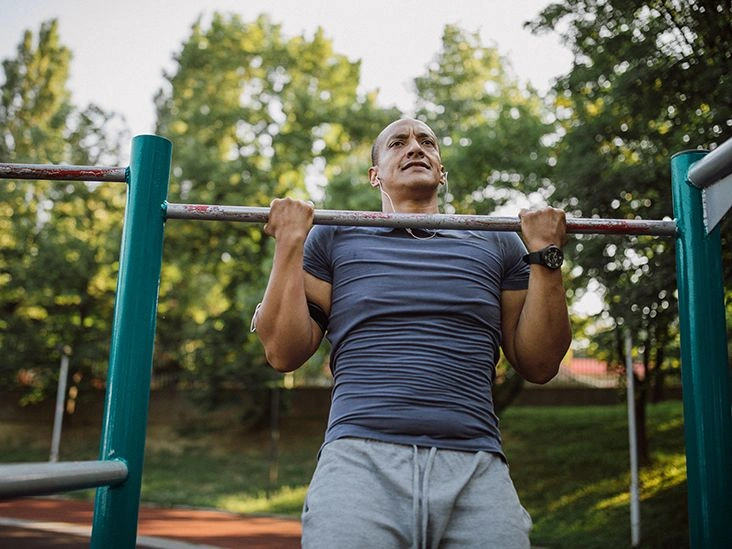Calisthenics are movements that utilize your own body weight as resistance. They help develop strength, endurance, mobility, and coordination.
Calisthenics originated long ago and experienced a resurgence in popularity during the early 19th century.
Nowadays, many people use these movements as a warm-up before intense sports or to condition specific muscle groups. Researchers are also exploring calisthenics as a therapeutic approach for a range of health issues, from obesity to COPD.
Calisthenic movements can be performed at various intensities and tempos. Occasionally they incorporate light handheld implements like rings, bars, or staffs.
Below is a full-body calisthenics circuit. Complete the sequence three times, resting 30 seconds between each exercise and taking a 3-minute break between circuit rounds.


20 dips

Dips are an excellent exercise to target your chest and triceps.
- Position yourself inside a dip station and use your arms and shoulders to lift your body off the ground.
- Bend your elbows and use your triceps to lower and raise your body.
If a dip bar isn’t available, perform dips using a bench or stability ball. Keep your feet planted and your knees bent at about a 90-degree angle.
25 jump squats

Jump squats combine strength development with cardiovascular conditioning.
- Stand facing forward with feet parallel and positioned under your shoulders.
- Slightly turn your toes outward and separate your feet a few inches.
- Sink into a squat by pushing your hips back and bending your knees.
- Maintain an upright chest and keep your head and gaze forward.
- Descend into as deep a squat as you can, then explode upward into a jump.
Avoid allowing your knees to travel past your toes during the descent, as this can strain the joint and raise the likelihood of knee injury.
20 pushups

Pushups are a classic and efficient bodyweight move that builds upper-body strength and stability. Some research also links pushup ability with a reduced risk of cardiovascular disease.
- Begin on your knees and place your hands slightly outside shoulder width.
- Extend your legs to raise your body into a plank position supported by your hands.
- Keep your back flat and avoid letting your hips sag or sticking your rear into the air.
- Lower your torso by bending your elbows until your chest nearly grazes the floor.
- Your upper arms should form about a 45-degree angle in the bottom position.
- Pause briefly at the bottom, then press back up to the starting position with speed.
- Maintain a braced core throughout the entire exercise.
If a full pushup is too difficult, choose a regression such as knee pushups or incline pushups against a wall.
Learn more about 5 beginner-friendly pushup variations.
50 crunches

Crunches focus on the abdominal musculature.
- Lie flat on your back on the floor.
- Place your feet on the ground with knees bent at roughly a 90-degree angle.
- Interlace your hands behind your head, keeping your head about a fist’s distance from your chest.
- With your core engaged, lift up until your elbows or chest approach your knees.
- Rely on your abdominal muscles to drive the motion, exhaling as you sit up and inhaling as you return.
10 burpees

Burpees are a compound bodyweight exercise that challenge multiple muscle groups and the cardiovascular system simultaneously.
In a study, participants reported greater psychological benefits and enjoyment from burpees compared with other forms of cardio like sprinting.
- Stand with feet shoulder-width apart, weight in your heels, and arms relaxed at your sides.
- Hinge your hips back and bend your knees into a squat.
- Place your hands on the ground slightly narrower than your feet.
- Shift weight onto your hands and jump your feet back so you land softly on the balls of your feet in a straight-plank position.
- Avoid letting your back sag or your hips rise too high.
- Jump your feet forward to land beside your hands.
- Extend your arms overhead and leap into the air.
30 seconds of jump rope

Skipping rope is an excellent way to elevate heart rate, improve muscular endurance, enhance balance, and tone muscles.
- Hold the rope handles with your hands roughly aligned with the center line of your body.
- Turn the rope using your wrists rather than your elbows or shoulders, and jump one to two inches off the ground to clear the rope.
- Keep toes pointed downward and maintain a slight bend in the knees as you jump.
Frequently asked questions
Can you build muscle with only calisthenics?
Yes, evidence indicates calisthenics can be as effective as resistance training with weights for increasing muscle strength and size.
Is 20 minutes of calisthenics enough?
A 2022 study involving 28 females with obesity suggested that a weekly 20-minute calisthenics session might confer some benefits. Still, public health bodies like the World Health Organization and other experts recommend aiming for at least 150 minutes of moderate activity weekly to reduce chronic disease risk.
Takeaway
Calisthenics leverage your bodyweight to build strength, stability, and cardiovascular fitness.
If you’re unsure whether calisthenics suit you, consult a healthcare provider. They can help design a safe exercise plan that lowers your risk of injury.


















Leave a Reply
You must be logged in to post a comment.